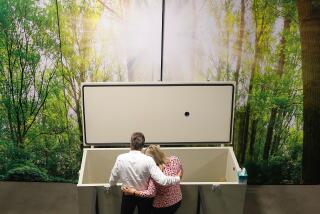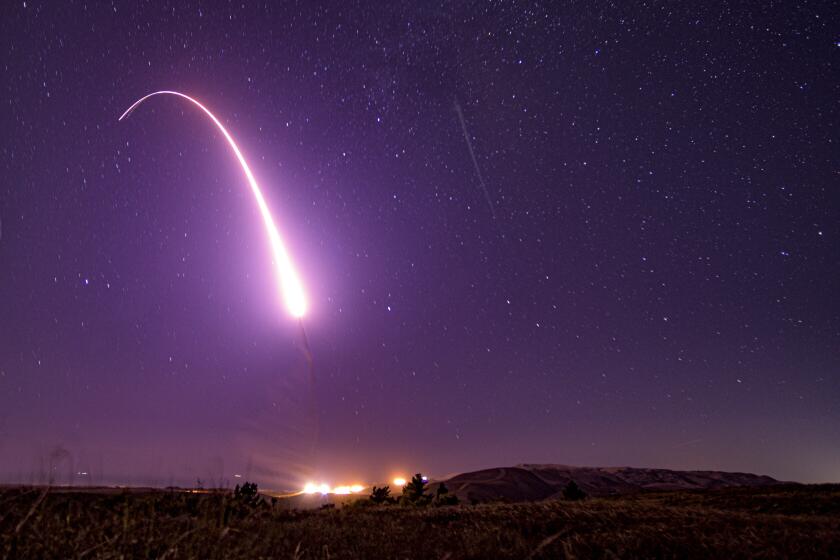Ground-Breaking Ceremony Today : S.D. Hospice Center Will Be a Family Affair
- Share via
Long before she decided to place her husband in the San Diego Hospice home health care program, June Moss knew he didn’t have much time left. The cancer spreading through his frail body had served ample notice of that.
Dignity in death was all she asked for her husband.
“I knew what the hospice stood for, that it was for the terminally ill,” said Moss, whose husband, Charles, died in 1985. “And, when I asked my doctor about it, he said that it was perfect for us. I wanted a program where he could receive good care and still be around his loved ones, something where he could die with dignity.
‘Made Things Easier’
“They showed me how to take care of him and made things a lot easier for us,” Moss said. “The hospice was just wonderful. I am very grateful to them and what they do for the community.”
Moss is now a volunteer at the hospice, and she will be one of 500 guests and workers expected to be on hand today at about 5:30 p.m. for the ground-breaking ceremony for the San Diego Hospice Center.
The center, to be built at 4311 3rd Ave. in Hillcrest, will be only the sixth of its kind in the country, according to Holly Lorenston, executive director of the San Diego Hospice. The 120-bed facility, scheduled to open in late 1989, will be the only free-standing inpatient complex in San Diego County, she said, and will provide care for patients suffering all types of terminal illness.
“This center will do a lot for the community,” Lorenston said. “Not only will it provide inpatient care for people with acute illnesses, it will also provide an environment for relatives to maintain involvement with their loved ones’ care.”
The San Diego Hospice originally planned to name the facility the Joan Kroc Hospice Center, after the McDonald’s restaurant magnate, but Kroc asked that her name not be used.
“The Joan Kroc Foundation was the foundation that provided us with the majority of the money needed for construction and furnishing,” Lorenston said. “But we need to find funds for an ongoing operation. That’s why we’re changing the name back. She didn’t want everybody to think that she had paid for everything. She wanted the community to be responsive.”
Sought Same for San Diego
Kroc inspired the idea for the center by donating $460,000 to the hospice in 1986, Lorenston said. Kroc had come to appreciate a hospice’s purpose while working with nurses in St. Paul, Minn., who were caring for her ailing father.
“She was really pleased with the quality of care,” Lorenston said. “She thought that San Diego didn’t have anything like this. She found out we did have hospices, but they were all home care. She wanted something like the (St. Paul inpatient center), so she donated the money to get it started.”
Kroc selected the San Diego Hospice, the oldest and largest in the county, as the target of her philanthropy. She donated the money for the land on Vauclain Point after a civic battle between her foundation and Hillcrest residents, who wanted the headland of the 10-acre tract to become a park.
The land originally belonged to J.A.P. Vauclain, a tuberculosis-stricken businessman who settled in San Diego in 1887. Before his death in 1909, Vauclain stipulated that a third of his estate be used to buy land and set up housing for tuberculosis victims.
The land served as a site for a health care center until 1984, when it became home to the San Diego AIDS Project. After a battle on the floor of the City Council, Kroc was able to purchase the land for the hospice.
Despite Kroc’s generosity, Lorenston said, the facility still faces financial problems.
“We need to raise an additional $1 million to take us through the first year,” she said. “For the first four months, we don’t get reimbursed by insurers whose clients use the facility. We have to provide care before Medicaid or Medi-Cal or any insurer certifies us. And most of our patients receive some form of medical aid.”
Hospice officials declined to release most other figures, however, such as the projected total costs for the facility. They said negotiations with Dunphy Construction Co. are incomplete, making estimates impossible.
Lorenston said a fund-raising drive will be launched in coming weeks, and noted that some benefactors have already been forthcoming.
Many of the guests who will attend today’s ground-breaking ceremony have donated $100 each for the release of a dove, or $20 for sending up a balloon, as memorials to their loved ones. The contributions total more than $40,000, officials said.
“I think this hospice is one of the most fantastic opportunities the community has,” said Dr. Pamela Johnston, a donor and part-time volunteer whose mother received care from the hospice’s home health care program until she died. “They kept my family sane while my mother was ill. If that center had been here when my mother was ill, it would have been much easier to care for her.”
Lorenston said that, although the center will offer care for AIDS victims--a hotly contested issue among residents living near such facilities--its diversity will help avert such controversy.
“This center will have people suffering all kinds of diseases,” she said. “It’s not just for AIDS patients. I don’t think people will get upset.”
The hospice has 100 paid staff members and cares for 160 patients, mostly in their homes. When patients require care outside their homes, the hospice contracts with local hospitals.
Lorenston predicted that, once word of the new facility spreads, the number of users will grow.
More to Read
Sign up for Essential California
The most important California stories and recommendations in your inbox every morning.
You may occasionally receive promotional content from the Los Angeles Times.










